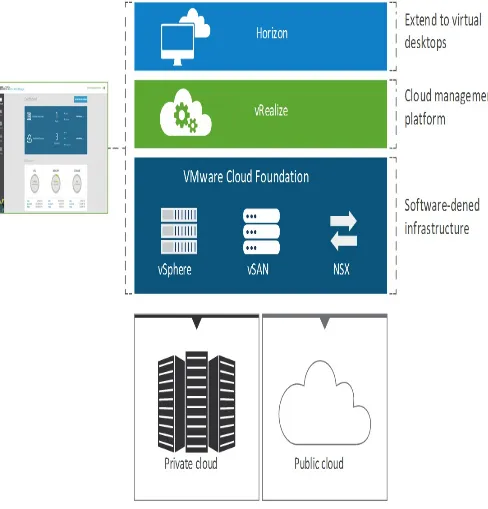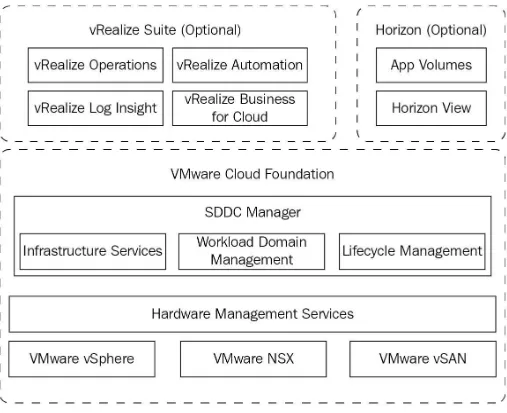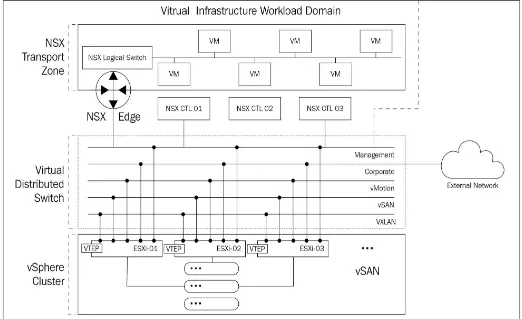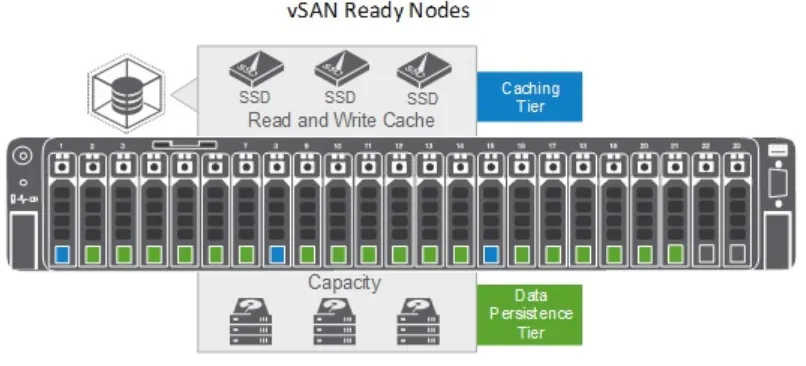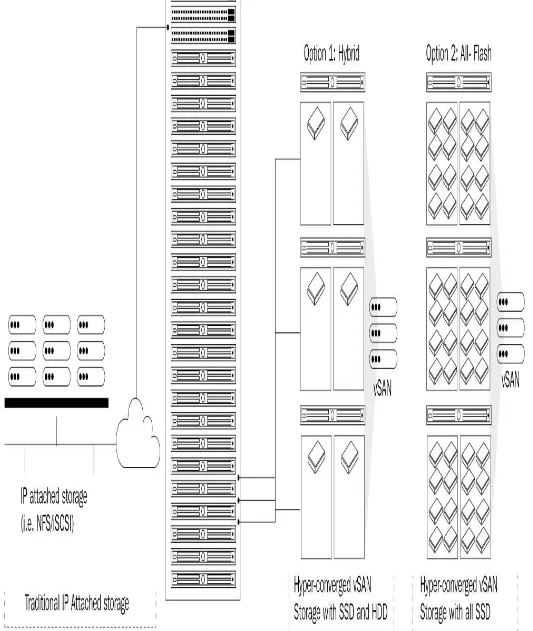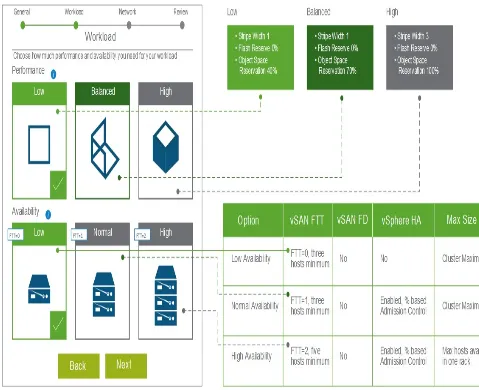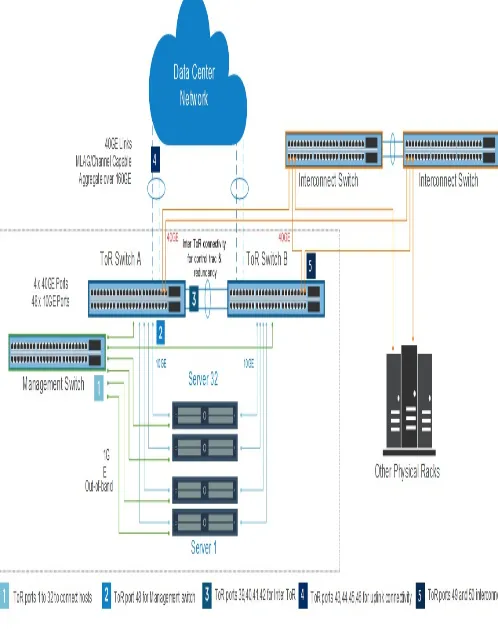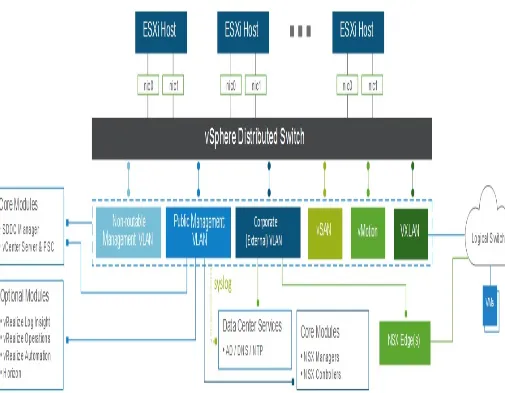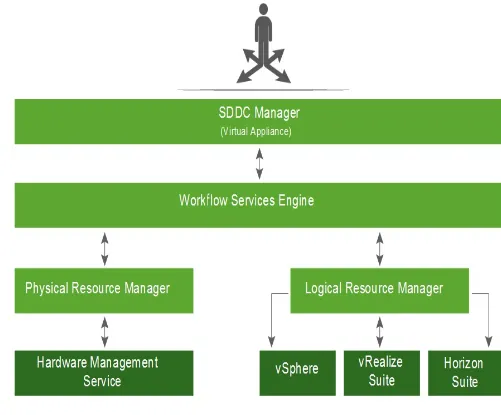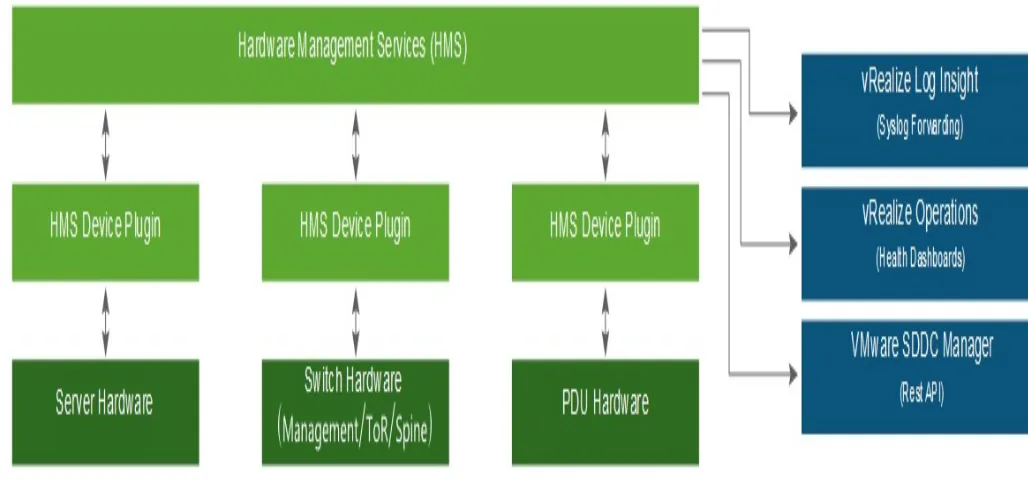VMware Cross-Cloud Architecture
Automate and orchestrate your Software-Defined Data Center on AWS
VMware Cross-Cloud
Architecture
Copyright © 2018 Packt Publishing
All rights reserved. No part of this book may be reproduced, stored in a retrieval system, or transmitted in any form or by any means, without the prior written permission of the publisher, except in the case of brief quotations embedded in critical articles or reviews. Every effort has been made in the preparation of this book to ensure the accuracy of the information presented. However, the information contained in this book is sold without warranty, either express or implied. Neither the author, nor Packt Publishing or its dealers and distributors, will be held liable for any damages caused or alleged to have been caused directly or indirectly by this book.
Packt Publishing has endeavored to provide trademark information about all of the companies and products mentioned in this book by the appropriate use of capitals. However, Packt Publishing cannot guarantee the accuracy of this information.
Commissioning Editor: Vijin Boricha
Acquisition Editor: Namrata Patil
Content Development Editor: Amrita Noronha
Technical Editor: Nilesh Sawakhande
Copy Editor: Safis Editing
Project Coordinator: Shweta H Birwatkar
Proofreader: Safis Editing
Indexer: Tejal Daruwale Soni
Graphics: Jisha Chirayil
Production Coordinator: Aparna Bhagat First published: March 2018
mapt.io
Why subscribe?
Spend less time learning and more time coding with practical eBooks and Videos from over 4,000 industry professionals Improve your learning with Skill Plans built especially for you Get a free eBook or video every month
Mapt is fully searchable
PacktPub.com
Did you know that Packt offers eBook versions of every book published, with PDF and ePub files available? You can upgrade to the eBook version at www.PacktPub.com and as a print book customer,
you are entitled to a discount on the eBook copy. Get in touch with us at service@packtpub.com for more details.
At www.PacktPub.com, you can also read a collection of free technical
About the author
Ajit Pratap Kundan is an infrastructure software consultant with 18 years' experience, having has worked with Novell, Redington, PCS, and Innodata. Currently, he is a technical consultant at VMware, Delhi and provides productive solutions for Federal Government clients, espousing the benefits of hybrid cloud with cross-cloud services. He has a graduate degree in electronics
engineering from Pune University with experience in Lotus, Tivoli, PlateSpin, IDM, SUSE Linux, Sentinel, and all of the VMware
products. He is an ITIL, CCNA, Lotus, SUSE, Red Hat, and VMware-certified professional.
About the reviewer
Daniel Jonathan Valik is an industry expert in unified
communications and collaboration technologies, cloud computing, and Platform as a Service (PaaS). He has worked for large software companies and start-ups in Europe, Asia (APAC), and the US. He is the founder of Hanako Consulting LLC—a strategy, product
marketing, and management consulting company. He has strong expertise in areas such as IoT, DevOps, Automation, Microservices, Containerization, Virtualization, Cloud-Native Applications,
What this book covers
Chapter 1, The Freedom with Cross-Cloud Architecture, introduces
different types of clouds, where we will learn about all of the cloud benefits that can help you to overcome traditional or multi-cloud challenges with Cross Cloud Architecture.
Chapter 2, Implementing Service Architecture for Cross-Cloud
Services, makes use of VMware Cloud Foundation deployment to achieve a unified software-defined data center (SDDC)
platform for the hybrid cloud, that is based on VMware compute, storage, and network virtualization, a natively integrated software stack that can be used on-premises for private cloud deployment or run as a service from the public cloud with consistent, simple
operations by integrating it with VMware vRealize Suite, VMware Horizon, and VMware Integrated OpenStack to deliver a
comprehensive SDDC platform.
Chapter 3, Transforming a Data Center from Silos to Software-Defined Services, explains how to host applications in the cloud world to provide administrators with flexibility and best control along with business values from Cross Cloud Architecture.
Chapter 4, Designing a Mixed Cloud Model with VMware, combines a
best-in-class private cloud with leading public clouds, all powered by the ever-reliable and most flexible hybrid cloud platform offered by VMware.
Chapter 5, Implementing Service Redundancy Across All Layers, talks
about different vCenter Server deployment topologies with redundant operations, and all of the High availability
functionalities of vSphere, such as vMotion, and different Fault Tolerance options comparing their strengths and weaknesses.
Chapter 6, Designing Software-Defined Storage Services, discusses
how to design and scale a software defined storage service and deep dives into reference deployment scenarios of VMware vSAN.
Chapter 7, VMware Cloud Assess, Design, and Deploy Service,
Chapter 8, Transforming Your Network Architecture, provides
examples of creating, provisioning, and managing networks in a software-defined way using the underlying physical network as a simple packet forwarding backplane, and also explains how to migrate from legacy network architectures to new network virtualization techniques.
Chapter 9, Dealing with Data Sovereignty, explains sovereignty
compliance strategies and how to use an encryption solution to secure data at all stages of the cloud journey. This chapter also shows you how to ensure that data backup and secondary data centers for data recovery/disaster recovery purposes remain local.
Chapter 10, Designing Effective Compliance Regulations to Fix Violations, explains design compliance regulations for multiple purposes by aligning line of business divisions with the best technology, such as VMware, to be compliant in this versatile market. Security and compliance must be a shared responsibility between IT and its cloud service provider.
Chapter 11, Lower TCO and Greater ROI with Maximum Agility,
explains that, in order to achieve the goal of cloud, we need to extend virtualization techniques across the entire data center to lower the capital and operational expenditure, achieving maximum ROI.
Chapter 12, VMware Pricing and Licensing for a Cross-Cloud Model,
discusses VMware Cloud Foundation pricing and licensing as well as other VMware Cloud component licensing models.
Chapter 13, The Economics of Cross-Cloud Services, explains a cost
Packt is searching for
authors like you
If you're interested in becoming an author for Packt, please visit aut hors.packtpub.com and apply today. We have worked with thousands of
developers and tech professionals, just like you, to help them share their insight with the global tech community. You can make a
Table of Contents
Packt is searching for authors like you Preface
Who this book is for What this book covers
To get the most out of this book Download the color images Conventions used
Get in touch Reviews
1. The Freedom with Cross-Cloud Architecture
Scaling your business with Cross-Cloud Architecture Top IT drivers for integrating public clouds
Cloud challenges and solutions
Challenge 1 – connection and security with full complianc e and control
Challenge 2 – managing/integrating across clouds VMware Cross-Cloud Architecture
Secure connectivity across clouds The backbone of a private cloud Extending services to public clouds
Multi-cloud/mixed cloud use cases
Cloud solutions supporting business objectives Modernizing your data center
VMware hybrid clouds
VMware – a partner for every cloud VMware vCloud Air
AWS hybrid cloud
IBM Cloud for VMware solutions Solution features
Reference architecture
IBM Cloud for VMware solutions Conceptual view
Logical view Deployment view Summary
Architecture overview
Seamless integration of software-defined services Automating IT infrastructure
Policy-based resource containers Automating manual and repetitive tasks Unified Management Console
Hardware architecture – rack architecture Rack hardware
Rack sizing Rack wiring
Storage architecture (software-defined storage) vSAN storage policies
Network architecture (network virtualization or software-defined network) Logical network design
VMware Cloud Foundation software design SDDC Manager
Physical Resource Manager Logical Resource Manager
LRM Controller
LRM logical resources and LRM services Hardware Management Service (HMS)
vRealize Automation, VMware vRealize Business, and VMware vRealize Orchestrator
Summary
3. Transforming a Data Center from Silos to Software-Defined Services Need for VMware in data center transformation
Business requirements of customers Interoperability and integration
Logical design
Orchestrator topology choice Orchestrator server mode choice
vRealize Orchestrator SDDC cluster choice
Integrated architecture design model for private and public clouds
Private cloud integrated architecture design with network and securit y
Integrated architecture design for virtual machines and applications Consumption model of network services components
vRealize Automation with logical switching consumption overview Introduction to DevOps and its benefits
Building, deploying, and running services in an innovative way SDDC object life cycle
vRealize code stream functionality
Automating application release without manual intervention Advantages of DevOps
Summary
4. Designing a Mixed Cloud Model with VMware
Core elements of VMware's Cross-Cloud Architecture Cross-Cloud Services
Choosing suitable applications to move in the cloud VMware Cloud on AWS
Components/technologies used in VMware-AWS partnerships Migrating your existing applications to AWS
Application migration phases with supporting tools Migration assessment
Schema conversion
Conversion of embedded SQL and application code Data migration
Testing converted code Data replication
Deployment to AWS and Go-Live Post-deployment monitoring Managing AWS with vCenter
Managing administrators on the management portal Steps for adding an administrator
Steps for removing an administrator VPCs and subnets management
Steps for creating a VPC and subnets Steps for deleting a VPC
Security groups management
Steps for creating a security group Steps for deleting a security group Environment management in AWS Steps for creating an environment Steps for deleting an environment User permissions management
VM migration to Amazon EC2 with AWS Connector for vCenter The VM import authorization process
Virtual machine migration process Backing up the instance
Migrated EC2 instance export process Troubleshooting migration
Validation of the certificates VMware Cross-Cloud Model with IBM Cloud
Prerequisites
Physical infrastructure Physical operational model
Logical operational model
Cluster (compute, storage, and network) architecture Compute clusters
Management cluster Edge cluster Storage cluster
Physical network provided by SoftLayer Simplicity
Network File System (NFS) Storage virtualization
VMware SDS is vSAN
Virtual Machine Disks (VMDK) Virtual infrastructure Network I/O control details Network virtualization services
Identity and access services DNS
NTP services
Simple Mail Transfer Protocol (SMTP) services Certificate Authority (CA) services
Cloud management services Service catalogue Self-service portal
Infrastructure and process orchestration Software orchestration
Monitoring
Log consolidation and analysis Patching
Business services
Business management IT financials IT benchmarking
Cloud-based approaches for Disaster Recovery as a Service (DRaaS) solution s
Summary
5. Implementing Service Redundancy Across All Layers vSphere virtualization software
VMware vCenter Management Server vCenter main components
Environment preparation
Certificate for the vSphere Web Client and the Log Browser Verify that the environment is working properly
Comparison of the vCenter deployment topologies vSphere HA/redundancy features
vSphere HA
vSphere vMotion details EVC feature details
vSphere DRS feature details
VMware vSphere Distributed Power Management Resource pools feature details
vSphere Fault Tolerance
Relevance of vSphere Fault Tolerance for vCenter HA VM Component Protection (VMCP)
vSphere Metro Storage Cluster (vMSC) vSphere Replication
vCenter Watchdog
vCenter database clustering Memory reservations
Maximizing memory performance
CPU and memory shares, reservations, and limits Virtual machine disks
Multiple virtual disks Virtual disk location Swap file location Virtual SCSI HBA type Virtual NICs
Virtual GPUs
VMware vSphere Flash Read Cache Guest operating system considerations VMware Tools
Templates and multiple sites Snapshot management
Virtual machine security considerations Encryption and security certificates
Monitoring and management design practices Time synchronization
Syslog logging
Performance monitoring
Virtual machine backup and restore VM-to-VM affinity rules
Backup and recovery - embedded deployment model Backup and recovery - external deployment model Migration architecture design Migrated virtual machine framework
Responsibility matrix Design risks
IaaS migration portal logical design VMware CMP physical design
VMware Converter Linux migration process VMware Converter agent
 Network/security changes Port requirements
Operational readiness for migration Pre-migration activities
P2V migration options
Hot clone - full outage
Hot clone – post-synchronisation V2V migration options
V2V conversion V2V requirements CMP migration process Timing estimate (P2V/V2V timing) Post-migration activities
Summary
6. Designing Software-Defined Storage Services Software-defined storage overview
Purpose and applicability to the SDDC solution Business requirements
Requirements and dependencies Architecture overview
Virtual SAN (vSAN)
vSAN design workflow
Design parameters/considerations for vSAN Hardware considerations
Comparing hybrid and all-flash designs SSDs
Magnetic hard disk drives I/O controllers
Host memory requirements Host CPU overhead
Hardware design decisions Network design
vSAN network port group Network speed requirements Type of virtual switch Jumbo frames
VLANs
Multicast requirements
Networking failover, load balancing, and teaming considerations Network design decisions
vSAN cluster and datastore design vSAN disk format
Disk groups
Failures to tolerate policy Fault domains
Hosts per cluster
Deduplication, compression, and RAID 5/RAID 6 erasure coding Datastore sizing
Virtual SAN TCO and Sizing Calculator vSAN cluster and datastore design decisions vSAN design assumptions Virtual SAN Health Check Plug-in Virtual SAN Observer
vRealize Operations Manager monitoring Monitoring design
Scalability limits of vSAN Product documentation and tools
VMware product documentation Supporting documentation Tools
7. VMware Cloud Assess, Design, and Deploy Services
VMware Cloud (SDDC) assessment, design, and deploy service solution overvi ew
Virtualization conceptual design Logical design
Virtualization logical design Cloud tenant design
Comparison of single tenant and multi-tenant deployments Single tenant deployment
Multitenant deployment Cloud automation IaaS design vSphere infrastructure
Integration with different cloud components vSphere integration
vRealize Operations Manager integration VMware vRealize Business Manager
Conceptual design
vRealize Business Standard architecture Data collection service
vRealize Business Standard appliance role Supported product integrations
VMware vSphere
VMware vCloud Director
VMware vRealize Business Advanced and Enterprise VMware vRealize Operations Manager
VMware vRealize Automation
Service orientation principle VMware vRealize Operations Manager
Business scenario
Interoperability requirements
Integration with vRealize Operations Manager
Integration between vRealize Operations Manager and vRealize Automation Business objective
Integration requirements Credentials
Firewall rules
Specific configuration with specific objects to be created and consumed
Application release automation with Zero Touch Deployment Summary
8. Transforming Your Network Architecture
Assumptions, risks, constraints, and use cases Design guidelines
Networking and distributed firewalling best practices Network virtualization
NSX for vSphere components NSX for vSphere platform NSX Manager
Distributed firewall Service composer
NSX for vSphere system requirements Micro-segmentation conceptual design
Network virtualization logical design NSX for vSphere component placement
High Availability of NSX for vSphere components Scalability of NSX for vSphere Components Firewall logical design
Distributed firewall
Security groups and policies NSX Manager design
Network virtualization platform management Consumption layer
NSX for vSphere logging environment NSX for vSphere management layer NSX for vSphere deployed components
Distributed firewall logs Distributed firewall monitoring
Backup and recovery – backing up the NSX Manager dat a
Backing up the vSphere Distributed Switch Monitoring and troubleshooting
Flow monitoring Activity monitoring
Port mirroring
vSphere Distributed Switch alerts
vSphere Distributed Switch network health check SNMP
NetFlow/Internet Protocol Flow Information Export (IPFIX) Performance and scalability
Scalability considerations VXLAN
MTU on the transport network NSX Controller
IGMP usage
Hybrid mode Brownfield migration
Migration inside the same hardware infrastructure Migration to a new hardware infrastructure
NSX for vSphere port and protocol requirements Reference documents
Summary
9. Dealing with Data Sovereignty Security
Securing ESXi hosts Lockdown mode Securing vCenter Server
Encryption and security certificates
Virtual network security considerations Network firewalls and vCenter Server Securing virtual machines with vLANs Securing virtual switch ports
Securing iSCSI storage connectivity Securing NFS storage connectivity Virtual machine security considerations
Security design decisions
Micro-segmentation – how to define security on east-west traff ic
PAN security – integrating NSX with Palo Alto
Application modeling for micro-segmentation – protecting your apps from east-west traffic in a data center
VMware vRealize Configuration Manager architecture design Backup and restore
General use cases of customers
vRealize Configuration Manager logical architecture overview VCM platform
Summary
10. Designing Effective Compliance Regulations to Fix Violations Best practices to follow for compliance regulations
Data collection Data analysis
Standard use cases
Network virtualization
NSX Edge Gateway Firewall and Trust Groups VMware vCloud Hybrid Manager
Phase 1 – Planning Phase 2 – Kickoff
Phase 3 – Solution overview Phase 4 – Assess
Phase 5 – Design Conceptual design
Logical design
VMware vRealize Configuration Manager platform vRealize Configuration Manager guest OS compliance Summary
11. Lower TCO and Greater ROI with Maximum Agility Operational readiness for the cloud
Phase 1 – Cost Center Phase 2 – Service Provider Phase 3 – Business Partner
Contrasting approaches to building a private cloud VMware Cloud Foundation
VMware Cloud Foundation infrastructure management A traditional 3-tier architecture-based private cloud Cost comparison methodology and approach
Hardware and software cost analysis
Cost comparison results - upfront costs for hardware, software, and s upport
Comparing the key technical capabilities and business benefits Integrated provisioning and life-cycle management
Support experience
Comparison of the key technical and business value attributes OpEx costs savings analysis
Virtualization First Policy Summary
12. VMware Pricing and Licensing for a Cross-Cloud Model Transforming a data center with Cloud Foundation VMware pricing and licensing in AWS Cloud
Summary
13. The Economics of Cross-Cloud Services
Total cost of ownership with cost categories Summary
Other Books You May Enjoy
Preface
Who this book is for
This book is intended for those planning, designing, and implementing the virtualization components of the SDDC foundational infrastructure. The intended audience is core technical teams, including those responsible for product
development, servers, storage, networking, security, and backup and recovery. It is assumed that the reader has knowledge of and familiarity with virtualization concepts and related topics
To get the most out of this
book
This book is intended for administrators with different levels of server, storage, and networking experience:
All administrators can learn network design and storage scaling to manage and monitor hosts in the vSphere environment.
Download the color images
We also provide a PDF file that has color images of the
screenshots/diagrams used in this book. You can download it here:
Conventions used
There are a number of text conventions used throughout this book.
CodeInText: Indicates code words in text, database table names, folder
names, filenames, file extensions, pathnames, dummy URLs, user input, and Twitter handles. Here is an example:
"Open Services.msc from the run command."
Bold: Indicates a new term, an important word, or words that you see onscreen. For example, words in menus or dialog boxes appear in the text like this. Here is an example: "The syslog service can be configured on ESXi using host profiles, the VMware vSphere
command line interface, or the Advanced Configuration options in the vSphere Web Client"
Get in touch
Feedback from our readers is always welcome.
General feedback: Email feedback@packtpub.com and mention the book
title in the subject of your message. If you have questions about any aspect of this book, please email us at questions@packtpub.com.
Errata: Although we have taken every care to ensure the accuracy of our content, mistakes do happen. If you have found a mistake in this book, we would be grateful if you would report this to us.
Please visit www.packtpub.com/submit-errata, selecting your book, clicking
on the Errata Submission Form link, and entering the details. Piracy: If you come across any illegal copies of our works in any form on the Internet, we would be grateful if you would provide us with the location address or website name. Please contact us at
copyright@packtpub.com with a link to the material.
Reviews
Please leave a review. Once you have read and used this book, why not leave a review on the site that you purchased it from? Potential readers can then see and use your unbiased opinion to make
purchase decisions, we at Packt can understand what you think about our products, and our authors can see your feedback on their book. Thank you!
The Freedom with
Cross-Cloud Architecture
This chapter briefs you on cloud service architectures. The chapter includes the following sections:
Cloud benefits and challenges
VMware solutions to overcome different cloud challenges VMware Cross-Cloud Architecture
Overview of private, public, and hybrid clouds Overview of vCloud Air, AWS, and the IBM Cloud
Readers will be able to design elastic IT infra capabilities and set up a basic application hosting and DevOps environment with VMware components after going through this book. You will be able to
Scaling your business with
Cross-Cloud Architecture
Digital transformation is taking place in each and every market segment, including financial services, healthcare, retail, education, and government. The world is being redefined by software and data, creating new priorities for every business, and new
imperatives for every IT organization. IT has to be agile enough to drive growth and extend the capabilities and services that they deliver to lines of business (LOBs). IT organizations have to transform their legacy setup and extend their IT environments to public clouds to boost innovation, agility, and cost savings.
IT is playing a key role in business growth. IT organizations work as strategic partners, and business leaders are seeking better
alignment with their technical teams as they evaluate go-to-market strategies and important decisions, such as mergers and
acquisitions.
Top IT drivers for
integrating public clouds
IT leaders cite three primary drivers for integrating public clouds: Disruptive approach: In today's disrupted, accelerated, app-centric marketplace, speeding up time-to-market is critical; LOBs and developers see public clouds as the fastest option for meeting their IT platform requirements.
CapEx pressures: IT teams are under considerable pressure to take advantage of potential cost savings. They are replacing on-premises infrastructures with public cloud-based hosting models or services, to increase capacity while reducing
operational efforts and costs. According to a Gartner research director, "Customers are saving 14 percent of their budgets because of public cloud adoption, which subsequently grow public cloud businesses."
A cloud-first strategy: Most senior leadership mandates a cloud-first strategy to drive reduced time to value by leveraging shared infrastructure and paying only for the resources
consumed. Many enterprises are already using hybrid clouds; some mix of private and public clouds, for greater flexibility and resilience.
Cloud challenges and
solutions
Challenge 1 – connection and
security with full compliance
and control
We have to manage incompatibility between different cloud models or service providers, otherwise it will create new silos and create overhead. You must avoid these silos and get a unified console to fulfill the requirements of the business objective. IT organizations are looking for ways to take advantage of the flexibility and agility that various clouds offer, even though many mission-critical and data-sensitive apps are currently running on-premises. We need to take a close look at how we can migrate applications running on-premises or in a private cloud to the public cloud, without adding any cost to their existing investments. We have to utilize the application design, SDLC processes, and maintain security and compliance best practices.
Solution: VMware overcomes this issue by extending a network to public clouds through a network virtualization technique. It
Challenge 2 –
managing/integrating across
clouds
We want to host our applications and manage resources in various clouds. As organizations invest in multiple clouds, they are also creating more complex, siloed environments that don't have common management tools or enterprise-class security across their cloud infrastructure. They may even build new teams to own and operate these different silos, reducing efficiency and driving up costs. Customers are looking for a solution that can help them to manage mixed clouds from a single console.
Solution: VMware will give you the holistic view from a single console of the entire infrastructure, and also management tools to monitor and manage resources, applications, and operations across different clouds. This approach prevents you from experiencing cloud vendor lock-in, monitoring operations, and managing specific service-level agreements (SLAs). You have holistic
management and your end users can connect to public clouds with confidence. A single unified management layer with automated processes delivers a fully customized cloud management platform, which gears up service delivery, enhances operations, and delivers end-user choice with control and compliance, across
VMware Cross-Cloud
Architecture
The VMware Cross-Cloud Architecture provides freedom for end users and control from a service provider perspective, helping a customer to make hybrid cloud decisions, when running,
managing, connecting, and securing all of their applications across any cloud in a common operating environment.
The Cross-Cloud Architecture enables uniform deployment models, security policies, visibility, and governance for all applications
running on-premises and off, irrespective of the underlying cloud or hypervisor.
The following architecture consists of SDDC-based VMware Cloud Foundation with a hyper-converged software solution, a set of
Secure connectivity across
clouds
Now the question is, how can we manage and monitor resources across mixed clouds with seamless control and compliant
connectivity? The answer is VMware Cross-Cloud Services, which is a set of services that will give users a common operating
platform to monitor, manage, govern, and secure applications running across private and public clouds. VMware Cross-Cloud Services will provide visibility of cloud resource consumption and map it to its costs, provide dynamic on-demand networks and security policies, and automate the process of deployment (Green Field or Brown Field deployments) and migration of applications and data (new or legacy) across both VMware-based and
heterogeneous clouds.
Cross-Cloud Serv ices prov ides a common operating platform across priv ate and public clouds
A single self service provisioning portal is good enough to monitor operations and manage resources of all of the customer's
workloads/applications across private and public clouds.
The different customer LOBs will be able to get their specific data on demand in their customized format at any time, such as costing of specific apps or managing certain SLAs to meet business
objectives.
Our goal is to provide all services across any cloud so users can consume these services without having any concern or doubts in mind.
hosted.
Cross-Cloud services will give unified cloud-network management, while a customer's LOBs can use public clouds as per their
business demand.
Customers will get tools to secure their data and applications, as well as control their costs, by enabling developers and the business to innovate across any cloud infrastructure that fits their
The backbone of a private
cloud
Customers used to say that their LOBs wanted IT resources on demand, as per their business objective. Their LOBs don't want to be dependent on the IT team, and want to consume IT services as per their need without any constraint on time and location. They want to provision apps to their end users on any device, at any time, and from any location. To achieve this, they need agile IT infrastructure that can provision them IT resources on demand from anywhere, anytime, and on any device.
For example, an Oracle database needs to be 100% available
24*7*365 days. Customers have to deliver more applications with the same resources without exceeding its TCO and at the same time, maintain the end user's demands by fulfilling all compliance parameters.
To build a robust private cloud while considering all the preceding parameters, we have to consider the following three mechanisms, which will provide customers with a resilient and flexible platform to run their businesses:
Virtualize all components of IT: Customers already know the benefits of compute virtualization. VMware can extend the same concept to storage and network for optimal utilization of hardware, based on the SDDC concept.
Automate IT: Virtualizing every component will drastically reduce your CapEx but you need to automate the process to reduce the Opex cost. A self service provisioning portal will help you to provision infrastructure as a service to different LOBs and this will reduce the dependency of LOBs on the IT team. It will speed up IT service delivery, which enables users to meet time to market demand and admin to monitor and manage for these services.
Support heterogenous environment: Today's digital business world demands collaboration between LOBs, developers, IT Infra teams, and support for digital business transformation and innovation. VMware has a private cloud solution with open APIs, to use OpenStack (VMware
benefits of containers.
We can build a private cloud integrated with all the required
hardware components in a single/multiple engineered box by using the hyper-converged infrastructure (HCI) concept (http://view.c eros.com/vm-ware/vmware-hci/p/1). It has seamless, integrated, unified
management, virtualized storage, network, and compute.
Customers can build HCI solutions with VMware hyper-converged software (vSphere and vSAN) on any x86 (Intel/AMD processors) server or, they can buy a fully integrated solution with all the
required hardware and software from any VMware partner, such as DELL, HP, Cisco, Fijitshu, Hitachi, Nutanix, Lenovo, and so on. VMware Cloud Foundation plus the hyper-converged concept gives you SDDC in a box, which simplifies the installation, update, and software life cycle management of a private cloud, as well as reducing Opex. It brings together compute, storage, and network virtualization, enabling customers to effectively leverage
virtualization technologies for efficiency, availability, performance, and scale.
It is also integrated with the vRealize cloud management platform and VMware SDDC Manager software, which helps customers to automate the deployment, configuration, and day-to-day
Extending services to public
clouds
Customers can extend their VMware private clouds smoothly to vSphere-based public clouds, such as the VMware vCloud Air public cloud service, in two ways:
The following diagram explains the common operating service platform:
Cross-Cloud Serv ices consumption model
The customer wants an instant way to build a disaster recovery solution or set up a test and dev environment. vCloud Air (also available from the vCloud Air Network of cloud providers) acts as a self-service virtual machine (VM) vending machine. It lowers the cost per application and utilizes existing investments with
100% compatibility, common management tools, and zero rewrites. It will also help customers with seamless app portability, which reduces time, risk, and cost. The following figure depicts
Traditional DR v ersus DR hosted in public cloud
Sometimes, customers want to build a private cloud in a public cloud environment and leverage the complete VMware SDDC stack, including full management and control.
The VMware Cloud Foundation, with leading cloud service
providers (IBM Cloud, Amazon Web Services, and vCloud Air), can deliver the full SDDC stack in a managed hybrid-cloud
environment as-a-service (EaaS) option.
Multi-cloud/mixed cloud use
cases
A combination of public cloud services with a private cloud provides you the best possible robust and elastic cloud strategy. You get all the freedom and flexibility with no cloud vendor lock-in. You can retrieve more values with continuous innovation. VMware has transformed data centers, with freedom and control over
hardware, and now VMware will provide you the same freedom and control over cloud options.
The following image shows that any app can be accessed any time, on any device in the VMware Cross-Cloud Services model:
Cloud solutions supporting
business objectives
Modernizing your data
center
Customers have to adopt new applications to align with the always-changing business requirements, and they can only achieve this by leveraging cloud-native technologies available on different
platforms/clouds.
Customers can avoid operational issues by integrating these new applications with existing IT operations. They can also move these existing applications to on-premises or public clouds. These
applications with cloud services can be redesigned/developed to adopt new IT models. VMware solutions help customers benefit from public clouds by migrating existing applications to the public cloud.
The Cross-Cloud Architecture helps customers to build, run,
connect, and secure apps across any cloud, and work in a common operating platform. Customers can build common platforms for future applications and digital business roadmaps, and avoid the bottlenecks of different cloud silos.
Customers will get more choices and interoperability with VMware Cross-Cloud Architecture and Cross-Cloud Services, in how to
build, run, and manage their applications in various kinds of cloud models from different vendors. Customers have the full freedom to deploy a solution based on an SDDC-based private cloud to a
VMware hybrid clouds
VMware hybrid clouds enable customers to run their existing legacy applications and new cloud-ready applications from a
common platform and get the best of both worlds. Customers can scale, consolidate, and migrate infrastructure on demand by taking advantage of existing tools, processes, and skill sets. They can
extend their on-premises infrastructure to a public cloud in a different location, or can set up disaster recovery sites in different regions. It will help in data center consolidation and application migration by improving dynamic capacity capabilities for new application development.
It supports applications by providing business agility, resilience, scalability, and any choice of public cloud provider, such as
VMware vCloud Air and vCloud Air network partners or, IBM
Cloud and Amazon Web Services (AWS) by extending their on-premises data centers. IT teams can run any application anywhere, with complete application portability thanks to the VMware Hybrid Cloud. They can maintain operational consistency by employing a common management experience and networking constructs to maximize use of existing skill sets and tools.
Organizations seeking to reduce CapEx investment can replace on-premises data center infrastructure with VMware Cloud
Foundation, a complete SDDC infrastructure platform, delivered as a service through VMware vCloudAir, VMware Cloud Foundation on IBM, and VMware Cloud on AWS. They can also take advantage of global scale and reach, with a presence in over 100 countries, vCloud Air, and 4,000+ vCloud Air network partners, including IBM and AWS.
Organizations are also exploring advanced management and automation for cloud brokering and integrating DevOps practices across multiple clouds. As needs change, they need an easy exit strategy for moving applications and virtual machines from any public cloud at any point, without vendor lock-in. VMware provides different options to customers to connect securely and manage multiple clouds with on-premises solutions or SaaS-based services. IT organizations can take advantage of VMware's cloud
different private and public clouds.
Customers can build and run applications, migrate them across multiple clouds, securely connect all clouds, and manage all workloads across networks. Advanced operations management features help to get a single unified console of the health,
performance, and capacity management of virtual machines across clouds plus policy-based governance. For organizations in heavily regulated industries such as financial services and healthcare, VMware helps ensure compliance by monitoring the status of workloads, detecting drift, and automating remediation.
With cost an ever-growing issue, IT teams can also leverage VMware solutions to see and control the cost of cloud services. VMware will help IT teams to manage any application or workload running on any cloud using Cross-Cloud Services (SaaS-based management and network services).
These planned service offerings include the on-boarding of existing cloud services and users, cloud service costing and reporting,
VMware – a partner for
every cloud
It's a multi-cloud world, but it takes an integrated approach for organizations to achieve their digital transformation goals.
Teaming up with VMware and standardizing on SDDC solutions that support both private and public clouds increases enterprise flexibility, security, and choice while rapidly reducing cost and risk. Over the last two decades, VMware has been the leader in
virtualization, and has held the top spot in Gartner's Magic/Leaders Quadrant for x86 Server Virtualization Infrastructure for more then seven consecutive years. VMware is positioned furthest in capability to execute and future roadmap vision in Gartner's latest report.
Customers can build a private cloud without any risk, which can extend seamlessly to compatible public clouds and run any
application on any cloud.
We have to be very cautious when choosing a hybrid cloud provider compared to private or public cloud solutions. We have additional challenges such as integration, interoperability, and common operating environments in deciding a hybrid cloud provider over a public or private cloud.
We choose a private or public cloud based on customer applications and business objectives. We have to know the feasibility of
applications while considering a hybrid cloud solution. We are going to make use of a hybrid cloud for extending
VMware vCloud Air
VMware's vSphere is one of the first tried and tested cloud operating platforms. vSphere hypervisor is rock solid in its
performance and reliability to become a first choice for most of the cloud providers. VMware vCloud Air is a vendor agnostic public cloud platform running Microsoft, Linux, and vSphere supported operating systems and applications as per customer choice. It provides a consistent and certified platform suited to most
operating systems, along with most of the applications running on x86 (32–64 bit) platforms (Intel/AMD). VMware uses the same vCloud software for both the private and public cloud deployments, along with all required APIs to keep seamless integration and
management of resources.
VMware also helps in software defined networking (SDN) concepts and brings that exposure to the hybrid cloud through NSX and virtualizing both network and security components to achieve micro-segmentation.
AWS hybrid cloud
AWS doesn't have the privilege of providing a hybrid cloud service as compared to the other cloud providers. AWS helps customers run/host applications in their public cloud data center and utilize AWS in a hybrid environment to run their DR or extended services. AWS is more focused on public cloud offerings and does not offer its cloud management software offsite to achieve common
operating environments for both worlds. AWS leverages a direct connect service that bridges the customer's data center with a virtual private cloud (VPC) resource to get a hybrid solution. AWS has the best of the best resources and expertise to manage the hosted side of a hybrid cloud, but they don't have a roadmap for on-premises private clouds, although they are one of the best public cloud providers. Direct connect is a specific connection from a VMware or Microsoft private cloud, but is not a universal connector to integrate with other cloud providers.
The AWS GovCloud program is a hybrid cloud offering that uses AWS for on-site private clouds for the US government. AWS doesn't have this option for private customers.
IBM Cloud for VMware
solutions
IBM Cloud for VMware Solutions help customers to improve the cost per application, reduce Opex, and have the agility to extend applications/services to the IBM Cloud. You can benefit from both cloud models by expanding or migrating workloads/services using secure and seamless networking capabilities that work in
heterogeneous environments, powered by VMware NSX. IBM
Bluemix bare metal servers on IBM Cloud will provide you with all these services by maintaining full control and compliance.
Solution features
The features listed are as follows:
Uniform management: Self service provisioning portal, seamless access, and monitors and manages a hybrid cloud with the VMware tools and skill sets you already have
Pay-as-you-go-model: Cost-effective CPU-based pricing of VMware software and pricing is per resource consumption Global data centers: IBM Cloud data centers have a
Reference architecture
IBM Cloud for VMware Solutions is based on Cloud Foundation technology and it helps with deployment, migration, and
management of these SDDC components in the IBM public cloud. You can partially deploy SDDC now to the IBM Cloud in an
automated way rather than doing it manually. Deployment and configuration, which used to take several weeks, can be possible within a few hours.
This easy and simple deployment helps you to focus on other innovative works rather than putting your man hours and money into building your own environment. As you are able to create
VMware SDDC on IBM Cloud
The VMware components in IBM Cloudware are:
VMwa re Cloud Found ation on IBM Cloud
VMwa
vCenter Server on IBM Cloud helps you in on-demand, automated deployments with integrated backup, which combines IBM Bluemix bare metal servers with vSphere and vCenter solution to create, deploy, and manage your virtual machines with scale up or scale out architecture as per customer requirements.
You can optimize, expand or migrate your virtual machines to high-performance, global cloud resources. You can customize your deployment in a cloud infrastructure to extend your footprint around the world on demand, and manage it all with a
management control that you are already familiar with.
The Cloud Professional Services team helps you to plan, design, deploy, and configure VMware solutions on bare metal servers. They will help with integration, virtual machine migration, or application portability.
Choose y our IBM Cloud and VMware Solution
IBM Cloud for VMware
solutions
We will discuss high-level architecture of cloud deployment. The basic factors to start with cloud architecture and its deployment strategy are as follows:
Cloud interfaces and formats must follow industry standards Information is needed to perform specific functions
End-to-end monitoring of all resource usage by both the cloud consumer and provider
Guarantee of reliability, availability, security, and performance Availability should be guaranteed at each and every layer
Compliant identity separation to avoid leakage of data to other customers
Full visibility and control
Enhance productivity and rapid growth with transformation of IT setup
Guaranteed data protection with full compliance and regulations
Conceptual view
The conceptual view has three key roles—the Service Provider, Consumer, and the Cloud Broker, as depicted here:
Cloud Conceptual v iew
The cloud provider role is the most critical among all three of them. We can't define scale for a cloud infrastructure and its specific
requirements easily. You have to plan and design cloud deployment and consider all SLAs while maintaining all regulatory governance and compliance.
Logical view
Access layers comprise two functionalities: interfaces and network, as shown here. The cloud has different interfaces to interact with the underlying services and its management capabilities. The access layer has end-user facing interfaces along with operator defined capabilities. The following figure shows natively stack with compute, storage and network pools:
Cloud logical v iew
Deployment view
Cloud deployment depends on the scale of deployment and the type of services. Private cloud implementations are very different
compared to large scale public cloud infrastructures that support hundreds of customers.
Summary
We have learnt about VMware SDDC technology-based cloud offerings in this chapter. SDDC systems lower costs while dramatically improving ease of use. Companies can deploy on-premises, private cloud infrastructure that has the ease of use and scalability of a public cloud, with guaranteed quality of service. Cross-Cloud solutions help you to deliver the only unified SDDC platform for the hybrid cloud (AWS, IBM, and vCloud Air), with customized and well-designed on-premises cloud service
deployment options.
Through an investment in VMware Cloud Foundation, companies can be assured that their data center infrastructure can be easily consumed, managed, upgraded, and enhanced to provide the best private cloud along with public cloud offerings, such as AWS and IBM, at the lowest cost. Using a modular, scale-out approach means infrastructure is added in hours, not days, and businesses can be assured that infrastructure scales linearly without any added complexity.
Choice is key: any app on any cloud at any time. Customers need a choice of where to run workloads. We shouldn't be forced into a single public cloud provider. We can choose the public cloud (such as AWS, IBM, vCloud Air, across the world) and not end up with applications trapped somewhere.
This book helps you understand why bimodal IT isn't necessarily the best path forward for the long term. We get the outcomes promised by bimodal IT without worrying about the inefficiencies that this model can introduce. Our users are far ahead of where they were a few years ago. Our infrastructure environment must reflect this fact by enabling user self service and automation, both of which are supported in an enterprise cloud scenario.
In the next chapter, we will discuss cloud services architecture and its different components, such as workload domains, racks, storage, networks, and VMware Cloud Foundation Software Design in
Implementing Service
Architecture for Cross-Cloud
Services
This chapter will brief you on VMware Cloud Foundation Deployment to get a unified software-defined data center
(SDDC) platform for the hybrid cloud. Based on VMware compute, storage, and network virtualization, this deployment delivers a
natively integrated software stack that can be used on-premises for private cloud deployment, or run as a service from the public cloud with consistent and simple operations. It can be further integrated with VMware vRealize Suite, VMware Horizon, and VMware
Integrated OpenStack to deliver a comprehensive SDDC platform. This chapter covers the following topics:
Architecture overview
Workload domain logical architecture Rack architecture
Storage architecture Network architecture
Architecture overview
VMware Cloud Foundation is the unified SDDC platform for the private and public cloud. Cloud Foundation brings together compute, storage, and network virtualization into a closely integrated stack that can be deployed on-premises or run as a service from the public cloud.
Figure 1 : Ov erv iew of VMware Cloud Foundation architecture
Seamless integration of
software-defined services
Automating IT
infrastructure
Cloud Foundation automates the installation of the entire VMware software components as the rack is installed and powered-on, and the networking is enabled. SDDC Manager leverages its knowledge of the hardware details and user-provided configuration details (such as DNS, IP address pool, and so on) to initialize the rack. This way, it saves a lot of time and prevents manual errors and repeated tasks. These activities include provisioning of workloads,
automated provisioning of networks, allocation of resources based on service needs, and provisioning of end points. It helps the
Policy-based resource
containers
You can create logical entities, such as workload domains, for creating resource pools across compute, storage, and networking components. A workload domain is a customized policy-based
logical entity with defined availability and performance parameters with compute, storage, and network in a single, consumable entity. You will get the required capacity with defined policies for
performance, availability, and security with each logical entity. As an example, it is possible to create one logical entity for test
workloads that require balanced performance and low availability, while for production workloads, which need high availability and high performance, a different entity will be defined.
SDDC Manager provides automation through its deployment
workflow to map the workload domain policies into the underlying pool of hardware resources (compute, storage, and network). These logical entities (workload domains) help you follow the best
practices to achieve customer operational objectives.
Automating manual and
repetitive tasks
Data center component upgrades and patch management are typically manual and repetitive tasks that are prone to
configuration and implementation errors. Validation testing and dependency checking of software and hardware firmware
maintains interoperability among components when one
component is patched or upgraded and requires extensive testing and downtime. Customers take the difficult decision to deploy new patches before they are fully tested or defer new patches, which slows down the roll-out of new features, security, and bug fixes. Both situations increase risks for the customers.
SDDC Manager automates upgrades and patch management for the SDDC software components, which improves reliability and
consistency of the IT infrastructure.
Unified Management
Console
SDDC Manager understands the physical and virtual architecture of the SDDC and the respective products' complementing each other, so it easily monitors the system to identify potential risks, performance issues, and failures. SDDC Manager has the capability of stateful alert management to avoid notification spam on
problem identification. Each notification has a brief detail of the problem and also helps in remediation steps required to recover the service. Performance issues or breakdowns are consolidated and examined for workload domains to get a detailed picture of any problem for the business service being implemented within a
Scalability and performance
Cloud Foundation helps to deliver a private cloud instance in both green field and brown field setups. Cloud Foundation
Workload domains
VMware Cloud Foundation creates a foundation for the SDDC by using workload domains. A workload domain is a policy-based resource container (logical architecture) with specific availability and performance attributes, and combines compute, storage, and network into a single consumable object for a specific purpose. Cloud Foundation includes the following workload domain types:
Management workload domain
Virtual infrastructure workload domain
Virtual desktop infrastructure (VDI) workload domain
This logical architecture is the foundation for the automated installation of software components, and helps to configure the appropriate services as per customer business objectives. Figure 2
Figure 2: Software component logical design
Cloud Foundation can help with automated installation and configuration for the following components:
SDDC Manager VMware ESXi hosts
VMware Platform Services Controller VMware vCenter Server
VMware NSX vSAN
VMware vRealize Operations Manager VMware vRealize Log Insight
VMware Horizon view VMware App Volumes
Management workload
domain
During the initialization process for Cloud Foundation, the
management workload domain is the first construct that is created after the imaging of the environment. The initialization process kicks off with the first login to SDDC Manager, where it defines the first four servers in each physical rack with the required
parameters in the management domain. You can spread the management domain whenever you need to.
The management domain manages all of the nodes in the rack. All disk drives are claimed by vSAN for shared storage in the rack. The management domain contains the following:
VMware vCenter Server Appliance NSX Manager
NSX Controller
vRealize Operations Manager vRealize Log Insight
SDDC Manager (includes hardware and lifecycle management services)
As soon as the management workload domain is created, the initialization process is completed. The system is available to
administrators from SDDC Manager, and helps to create the other types of workload domains for use.
Workload domains
Cloud administrators can scale and customize the underlying components to meet a customer's changing business objectives. Administrators have the option to deploy all certified operating systems and application stacks from different vendors with workload domains. Administrators have monitoring rights to monitor the underlying components by using a common
monitoring tool set that consolidates and relates across physical and virtual infrastructures.
During the creation of a workload domain, the workflow configures a flexible virtual data center that provides:
The ability to deploy and configure OS instances in the form of VMs with vCPUs, memory, and storage, including networking resources
Internet connectivity with a built-in IP Address Management (IPAM) solution
The following diagram represents a virtual infrastructure workload domain:
You can opt for a modular approach to match your customers' data center capacity requirements, and you can justify better TCO/ROI to your customers with the resulting virtual infrastructure. SDDC Manager deploys the following:
Physical compute: This means processing resources
(CPU/RAM) with storage and network connectivity to create a resource pool by abstracting from hardware components. Virtual infrastructure: One management server should be required per workload domain (logical entity), which connects to the services controller in the management domain for
required authentication and licenses. It creates logical entities as defined in a policy object by adding servers and creating storage data stores from the built-in storage (SSD/HDD) that resides in these servers. It also abstracts networking
components and configures virtual switches on each server. Physical networking: SDDC Manager leverages the
hardware management services to configure the top of rack (ToR) switches. These switches are responsible for VLAN traffic in the virtual data center, and also routes traffic for the public logical networks as defined in the policy.
Management: VMware automation tools will help you monitor and manage these logical entities.
VDI workload domains
You can deliver virtual or hosted desktops and applications through a single VDI platform with VMware Horizon. End users can access all of their desktops and applications through a single, unified workspace.
Cloud Foundation provisions the hardware resources in this way to deploy the required SDDC components in a fully functional
environment that also auto-configures the physical infrastructure while hosting virtual desktops or applications.
Figure 5: VDI workload domain design
SDDC Manager deploys the following for the provisioning of virtual desktops:
Physical compute: This means processing resources
(CPU/RAM) with storage and network connectivity to create resource pools by abstracting from hardware components. Virtual infrastructure: One management server should be required per workload domain (logical entity), which connects to the services controller in the management domain for
required authentication and licenses. It creates logical entities as defined in a policy object by adding servers and creating storage data stores from the built-in storage (SSD/HDD) that resides in these servers. It also abstracts networking
components and configures virtual switches on each server. Physical networking: SDDC Manager leverages the
hardware management services to configure the ToR switches. These switches are responsible for VLAN traffic in the virtual data center, and also routes traffic for the public logical
networks, as defined in a policy.
Management: VMware automation tools will help you monitor and manage these logical entities.
VDI: Cloud Foundation can be integrated with VMware Horizon and helps to automate the installation process of connection servers, security servers, app volumes, composer servers, and a DHCP relay agent as per the customer's defined policy and configuration, with full control and compliance. You can create a desktop/application pool with user/group
entitlements as per the organizational policy. VDI can facilitate the following tasks:
Integration with LDAP/Active Directory server (for user source or creating additional users/groups with group policy) for
authenticating users/groups.
Publishing desktop/applications (persistent/floating,
Windows/Linux OSes, and virtualized/legacy apps) as per the customer's business objectives on demand.
Hardware architecture –
rack architecture
VMware Cloud Foundation is a hardware integrated solution. This means that it not only provides software configuration, but also provides automation for much of the physical hardware
Figure 6: Cloud Foundation rack
A Cloud Foundation rack consists of the following components: Spine switches: This system comes with two spine switches that extend the network schema of the top of rack switches between racks and enables inter-rack connectivity. You can communicate between the uplink ports of the ToR switches and the spine switches. We require spine switches in multi-rack deployments, which are located in the second multi-rack.
Management switch: The management switch helps public connectivity with the baseboard management controller on each server. vSphere management, vSAN, or vMotion traffic runs on the network fabric generated by the ToR and spine switches. The management switch lacks redundancy in the physical rack. Components associated with management switches can't be customized or modified, but virtual machines/applications can be protected with maximum availability and performance.
Top of rack switches: A physical rack comes bundled with two ToR switches, with 48 10GE ports and a minimum of four 40 GE uplink ports. The ToR and spine switches are capable of taking care of all network traffic (including VM network, VM management, vSAN, and vMotion traffic) from the servers with a guarantee of zero data loss and zero down time. The ToRs switches are designated for traffic to the main network through two of the uplink ports on rack 1. ToR switches are capable of providing more bandwidth with maximum
availability for relentless operation. Each spine switch
communicates with two Uplink ports from each ToR switch on every rack.
Servers: You can scale up servers/nodes on the rack up to a maximum of 32 servers. It supports both scale up and scale out architecture. All servers/nodes should be of the same model and type within a rack. The disk size and storage
configuration must be the same. Memory and CPU (per CPU core count) between servers can be different. Check
Rack hardware
The hardware that must be used by Cloud Foundation is tightly controlled due to the hardware integration and automation. The rack has to use:
As specific vSAN ReadyNode
Specific physical switches for management, ToR, and spine connectivity
This allows the system to take advantage of vSAN technologies, and allows for tight integration with specific vSAN ReadyNodes. The following diagram depicts a vSAN ReadyNode and resultant disks, allowing vSAN shared storage to be used:
Figure 7 : v SAN Ready Nodes
The VMware Cloud Foundation compatibility guide lists the
supported hardware. Hardware must be on the compatibility list to be fully supported. The compatibility list can be found at
Rack sizing
VMware Cloud Foundation supports up to eight racks in a single SDDC Manager instance. Each rack supports up to 32 hosts and currently has a separate management domain configured on
servers in that rack. The Cloud Foundation software versions must be identical to be supported for multiple rack configurations.
Any rack that is added must have homogeneous hardware in that rack to be in a supported configuration. Hardware configuration, however, might be different between the different racks, which gives flexibility to the expansion.
Rack wiring
Storage architecture
(software-defined storage)
The primary source of storage for Cloud Foundation is vSAN. For example, a 1U server can have eight disks in the capacity tier and two disks in the caching tier. All disks are claimed by vSAN for software-defined storage.
The amount of available physical storage in workload domains depends on the number of physical hosts. The total capacity that is usable is also dependent on the availability requirements for the workload domains that are being configured. Storage policies are configured and specific to the workload being configured.
Figure 8: v SAN storage design
In this configuration, storage traffic is carried over the 10 GBPS links between the hosts and ToR switches. All vSAN members communicate over this 10 GBPS network. Best practices
